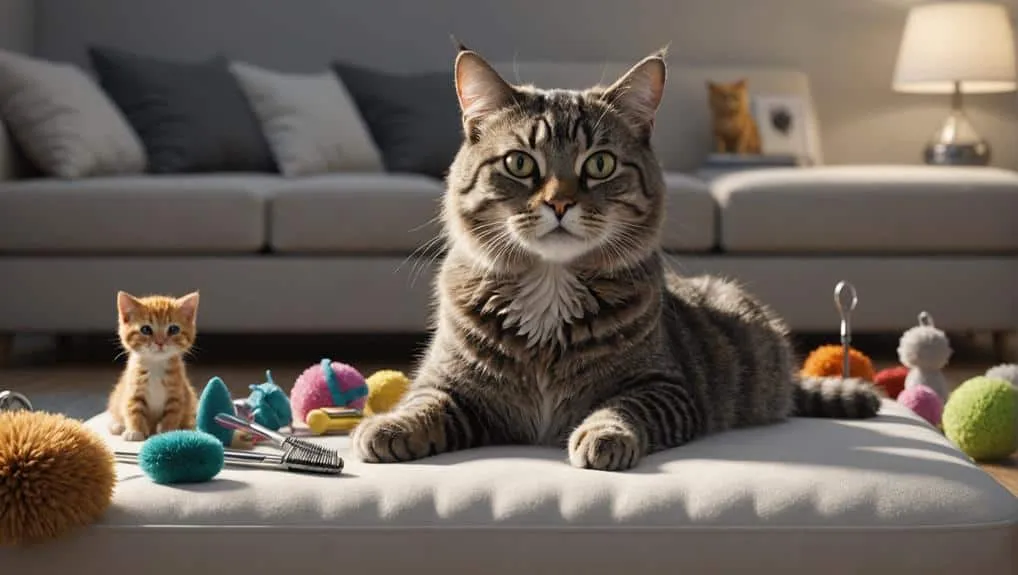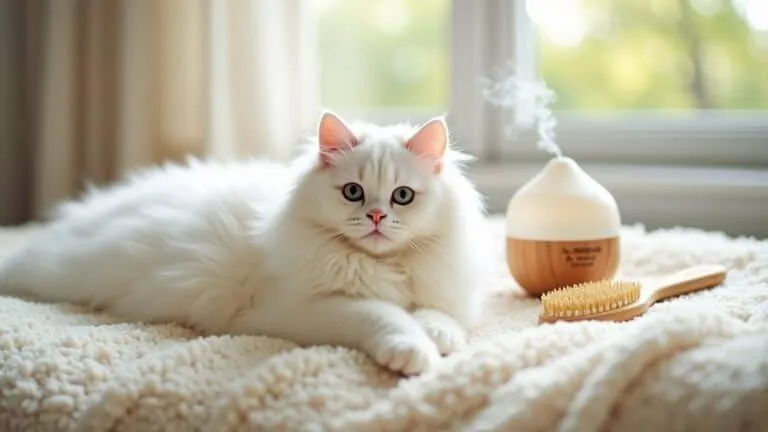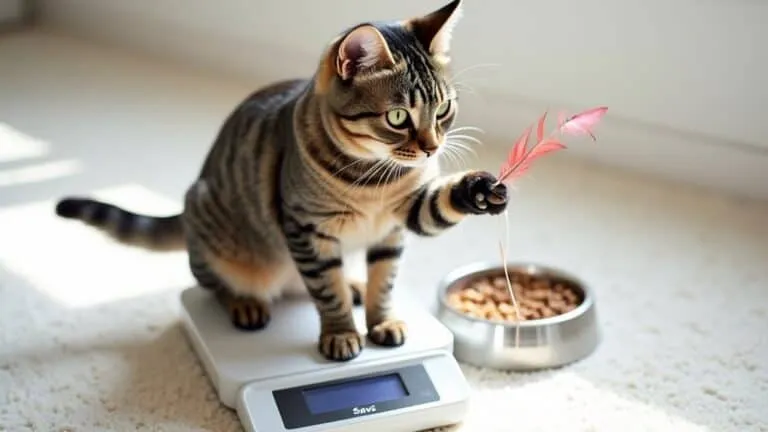The Best Fluffy Pancakes recipe you will fall in love with. Full of tips and tricks to help you make the best pancakes.

Grooming your cat is about more than just making them look pretty – it's also crucial for their hygiene and overall health. When you groom your cat regularly, you're removing dirt, debris, and loose hair that can cause skin irritations and infections.
By brushing your cat regularly, you can reduce shedding by up to 90%. This means less hair around the house, making your living space cleaner. Using the right grooming tools and techniques also helps promote air circulation in their coat, which prevents overheating.
Grooming is also a great opportunity to check for skin issues and parasites. By doing so, you'll be able to catch any potential problems early on.
Plus, as you master the basics of grooming, you'll discover even more benefits for both you and your feline friend.
Importance of Regular Grooming
Regular grooming is a must for your cat's health, hygiene, and overall well-being. Not to mention, it also keeps your living space clean and fur-free.
When you brush your cat regularly, you can reduce shedding by up to 90%. This means less fur floating around your home, making it a cleaner and more comfortable space for everyone. Brushing also helps with air circulation in your cat's coat, which prevents overheating—especially during those hot summer months.
Grooming sessions are also a great way to bond with your cat. It's quality time that can help reduce stress for both you and your pet. Plus, regular grooming allows you to catch any skin issues or parasites early on, so you can get them treated quickly and prevent more serious problems.
By grooming your cat regularly, you can prevent matting and tangles, which can be uncomfortable for them and make future grooming sessions more challenging. With the right tools and a gentle shampoo, you can keep your cat's skin and coat healthy and well-groomed.
Investing time in regular grooming is a win-win. You'll be improving your cat's overall health, strengthening your bond, and creating a more pleasant living environment.
Grooming Techniques and Tools
When it comes to grooming your cat, you need to choose the right tools and techniques. This is crucial for managing their fur effectively and keeping them comfortable.
Regular brushing is a big part of this process. It helps remove loose fur, dirt, and debris, and prevents matting in their coat. To get the best results, use grooming tools that are suitable for your cat's coat type. For example, use slicker brushes for short-haired cats and grooming gloves for long-haired breeds.
You should avoid using scissors, as they can cause injury to your cat's delicate skin. Instead, use clippers to deal with large tangles or mats. It's also important to regularly clean and maintain your grooming tools to prevent skin irritations.
When it's time to bathe your cat, use hypoallergenic shampoos and conditioners. These promote skin health and avoid harsh chemicals.
Seasonal Grooming Considerations
As you adjust your grooming routine to the changing seasons, you'll want to keep in mind the unique challenges that come with each time of year.
During the summer, many cat breeds shed more, making regular grooming crucial to manage all that loose fur and keep your home clean. One thing to remember is that shaving your cat isn't recommended, since their natural fur provides insulation and protects them from sunburn. It's best to leave at least an inch of hair.
Long-haired breeds like Persians need more frequent grooming during the warmer seasons to prevent tangles and mats as they shed their winter coat.
Seasonal changes can also trigger allergies, so you'll want to keep a closer eye on your cat's coat health and groom them more often to keep their skin clean and reduce irritants. By making regular grooming a priority during shedding seasons, you can prevent hairballs from forming and reduce the frequency of more complex grooming challenges – for both you and your cat.
Health Assessments and Symptoms
Regular grooming sessions are a great opportunity to check your cat's health and catch any potential issues before they become serious problems.
When you're grooming your cat, take a closer look at their skin. Check for signs of skin problems, such as excessive scratching, redness, and bald patches. These could be indicators of underlying health issues or infections that need attention.
Here's a quick rundown of what to look out for in different areas of your cat's body:
Ears: They should be light pink and free of debris. If you notice wax buildup, an unusual odor, or sensitivity, it could be a sign of ear infections or mites.
Teeth and Gums: Your cat's mouth shouldn't have a strong odor, and they shouldn't be drooling excessively. If you notice either of these, it could be a sign of dental diseases that need veterinary evaluation.
Skin: Your cat's skin should be healthy and free of flaky patches or dryness. If you notice any of these, it could be a sign of skin problems or underlying health issues that require veterinary attention.
Overall Health: A healthy cat should show no signs of illness and be energetic. If you notice anything unusual, it could be a sign of underlying health issues or infections that need veterinary evaluation.
Behavioral Aspects of Grooming
Grooming can be a really comfortable and relaxing experience for your cat if you approach it the right way. By using positive reinforcement techniques, you can help your cat associate grooming with feelings of calmness and relaxation. This can reduce anxiety and make them more willing to go along with the process.
One key thing is to establish a consistent grooming routine. This helps your cat get used to the experience, and over time, they'll become more cooperative. It's also important to create a calm atmosphere during grooming sessions. If you notice your cat getting stressed or uncomfortable, take a break. Positive reinforcement like treats and gentle praise can go a long way in making your cat view grooming as a pleasant experience.
Regular grooming has a lot of benefits beyond just making your cat look good. It helps keep their coat healthy, and it's also good for their skin and overall well-being. Grooming improves circulation, which can help prevent painful tangles and hairballs – problems that can affect both long-haired and short-haired breeds.
Frequently Asked Questions
Do Cats Need a Sanitary Trim?
So, do cats really need a sanitary trim? Well, the thing is, they're pretty good at taking care of themselves, but there are some situations where a trim can be really helpful. For instance, if your cat is overweight, a trim can help prevent matting and keep them clean in areas that are hard to reach. Similarly, if your cat has skin issues, a trim can be beneficial in preventing irritation and keeping the skin healthy.
How Do I Keep My Cat Clean and Hygienic?
So, you want to keep your cat clean and hygienic. That's a great goal! To do this, you'll need to get familiar with a few important tasks.
First, you'll want to learn how to bathe your cat properly. This can be a bit tricky, so it's good you're thinking about it. You'll also need to brush your cat regularly to prevent matting and tangling, which can be painful for them.
Dental care is another crucial aspect of keeping your cat clean. You'll need to learn how to clean their teeth and gums to prevent bad breath, gum disease, and other problems.
In addition to these tasks, you should also prioritize nail trimming, ear cleaning, and fur matting solutions. These can help prevent shedding, skin issues, and allergies. And let's not forget about controlling fleas – they can be a real nuisance for your cat's health and comfort.
Do Indoor Cats Need to Be Groomed?
So, you're wondering if your indoor cat needs to be groomed? The answer is yes, regular grooming is essential for your cat's overall health and well-being.
Think about it, when your cat is outdoors, it naturally sheds its coat and gets rid of dirt and debris. But since your cat is indoors, it's up to you to help with that process. Brushing your cat regularly can help reduce shedding, prevent hairballs, and even reduce allergy symptoms.
But grooming is more than just brushing. You should also trim your cat's nails regularly to prevent overgrowth, which can be painful for your cat. And let's not forget about ear cleaning and dental care. These are crucial for preventing infections and monitoring your cat's overall health.
How Do I Give My Cat a Sanitary Shave?
When it comes to giving your cat a sanitary shave, it's super important to prioritize their comfort and safety. You want to make sure they're not getting stressed out or uncomfortable during the process.
To do this, use gentle grooming techniques that your cat is used to. You can also use specialized equipment designed specifically for cats, which will make the process much easier and safer for both you and your cat.
It's also a good idea to have some anxiety-reducing strategies up your sleeve. This could be something as simple as giving your cat treats or toys to distract them from what's going on, or even just taking regular breaks to let them relax and calm down.
Final Thoughts
When it comes to your cat's hygiene, regular grooming is a must. It's essential for their overall health, and it's not just about looking good – it's about feeling good too.
Mastering different grooming techniques and using the right tools can make all the difference. You'll be able to remove dirt, reduce shedding, and even prevent skin issues from popping up.
But it's not just about the grooming itself – it's also about paying attention to your cat's behavior and the changes that come with the seasons. If you notice anything unusual, it could be a sign of an underlying health issue.
By staying on top of these things, you'll be able to support your cat's well-being and build a strong bond with them through the grooming process.








